Open list
Open list describes any variant of party-list proportional representation where voters have at least some influence on the order in which a party's candidates are elected. This is as opposed to closed list, which allows only active members, party officials, or consultants to determine the order of its candidates and gives the general voter no influence at all on the position of the candidates placed on the party list.
| Part of the Politics series |
| Electoral systems |
|---|
.svg.png.webp) |
|
|
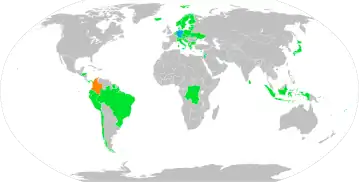
Additionally, an open list system allows voters to select individuals rather than parties. Different systems give the voter different amounts of influence to change the default ranking. The voter's choice is usually called preference vote; the voters are usually allowed one or more preference votes to the open list candidates.
Variants
Relatively closed
A "relatively closed" open list system is one where a candidate must get a full quota of votes on their own to be assured of winning a seat. (This quota, broadly speaking, is the total number of votes cast divided by the number of places to be filled. Usually, the precise number required is the Hare quota, but the Droop quota can also be used.)
The total number of seats won by the party minus the number of its candidates that achieved this quota gives the number of unfilled seats. These are then successively allocated to the party's not-yet-elected candidates who were ranked highest on the original list.
Iceland
In both parliamentary and municipal elections, voters may alter the order of the party list or strike candidates from the list completely. How many votes need to be altered in this way to have an effect on the results varies by the number of seats won by the party in the constituency or municipality in question and the candidate's place on the list.[1] In the parliamentary elections of 2007 and 2009, voters altered the party lists enough to change the ranking of candidates within party lists. This did however not affect which candidates ultimately got elected to parliament.[2]
Norway
In parliamentary elections, 50% of the voters need to vote for a candidate in order to change the order of the party list, meaning that, in practice, it is almost impossible for voters to change the result and it is de facto a closed list system. In county elections there is a threshold of 8%.[3]
Ley de Lemas
The Ley de Lemas allows the voter to indicate on the ballot the preference for different political factions or lists of candidates within a political party.
More open
In a "more open" list system, the quota for election could be lowered from the above amount. It is then (theoretically) possible that more of a party's candidates achieve this quota than the total seats won by the party. It should therefore be made clear in advance whether list ranking or absolute votes take precedence in that case. The quota for individuals is usually specified either as a percentage of the party list quota, or as a percentage of the total votes received by the party.
Example: The quota is 1000 votes and the open list threshold is specified as 25% of the quota, i.e. 250 votes. Therefore, a party which received 5000 votes wins five seats, which are awarded to its list candidates as follows:
| Candidate position on the list |
Preference votes | 25% of the quota | Elected |
|---|---|---|---|
| #1 | 3500 | x (first) | x |
| #2 | 50 | x | |
| #3 | 150 | x | |
| #4 | 250 | x (third) | x |
| #5 | 100 | ||
| #6 | 100 | ||
| #7 | 450 | x (second) | x |
| #8 | 50 | ||
| ... | ... | ||
Candidates #1, #7 and #4 have each achieved 25% of the quota (250 preference votes or more). They get the first three of the five seats the party has won. The other two seats will be taken by #2 and #3, the two highest remaining positions on the party list. This means that #5 is not elected even though being the fifth on the list and having more preference votes than #2.
In practice, with such a strict threshold, only very few candidates succeed to precede on their lists as the required number of votes is huge. Where the threshold is lower (e.g. in Czech parliamentary elections, 5% of the total party vote is the required minimum), results defying the original list order are much more common.
Parties usually allow candidates to ask for preference votes, but without campaigning negatively against other candidates on the list.
Austria
The members of the National Council are elected by open list proportional representation in nine multi-member constituencies based on the states (with varying in size from 7 to 36 seats) and 39 districts. Voters are able to cast a single party vote and one preference votes each on the federal, state and electoral district level for their preferred candidates within that party. The thresholds for a candidate to move up the list are 7% of the candidate's party result on the federal level, 10% on the state level and 14% on the electoral district level.[4] Candidates for the district level are listed on the ballot while voters need to write-in their preferred candidate on state and federal level.
Croatia
In Croatia, the voter can give their vote to a single candidate on the list, but only candidates who have received at least 10% of the party's votes take precedence over the other candidates on the list.[5]
Czech Republic
In Czech parliamentary elections, voters are given 4 preference votes. Only candidates who have received more than 5% of preferential votes at the regional level take precedence over the list.[6] For elections to the European Parliament, the procedure is identical but each voter is only allowed 2 preference votes.
Indonesia
In Indonesia, any candidate who has obtained at least 30% of the quota is automatically elected.[7]
Netherlands
In the Netherlands, the voter can give their vote to any candidate in a list (for example, in elections for the House of the Representatives); the vote for this candidate is called a "preference vote" (voorkeurstem in Dutch). Candidate with at least 25% of the quota takes priority over the party's other candidates who stand higher on the party list but received fewer preference votes. Most people vote for the top candidate, to indicate no special preference for any individual candidate, but support for the party in general. Sometimes, however, people want to express their support for a particular person. Many women, for example, vote for the first woman on the list. If a candidate gathers enough preference votes, then they get a seat in parliament, even if their position on the list would leave them without a seat. In the 2003 elections Hilbrand Nawijn, the former minister of migration and integration was elected into parliament for the Pim Fortuyn List by preference votes even though he was the last candidate on the list.
Slovakia
In Slovakia, each voter may, in addition to the party, select one to four candidates from the ordered party list. Candidates who are selected by more than 3% of the party's voters are elected (in order of total number of votes) first and only then is the party ordering used. For European elections, voters select two candidates and the candidates must have more than 10% of the total votes to override the party list. In the European election in 2009 three of Slovakia's thirteen MEPs were elected solely by virtue of preference votes (having party-list positions too low to have won otherwise) and only one (Katarína Neveďalová of SMER) was elected solely by virtue of her position on the party list (having fewer preference votes than a number of other candidates who themselves, nevertheless had preferences from fewer than 10 percent of their party's voters).
Sweden
In Sweden, the "most open" list is used, but a person needs to receive 5% of the party's votes for the personal vote to overrule the ordering on the party list.[8] Voting without expressing a preference between individuals is possible, although the parties urge their voters to support the party's prime candidate, to protect them from being beaten by someone ranked lower by the party. The share of voters using the open list option at 2022 Swedish general election was 22.49%.[9]
Most open
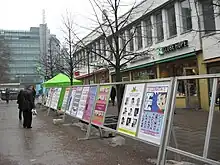
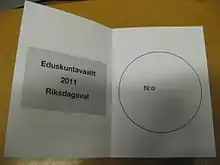

The "most open" list system is the one where the absolute number of votes every candidate receives fully determines the "order of election" (the list ranking only possibly serving as a "tiebreaker").
When such a system is used, one could make the case that within every party an additional virtual non-transferable vote election (single or multiple based on the number of preference votes available to the voters) is taking place.
This system is used in all Finnish, Latvian and Brazilian multiple-seat elections. Since 2001, lists of this "most open" type have also been used in the elections to fill the 96 proportional seats in the 242-member upper house of Japan (the other 146 are elected through a majoritarian, SNTV/FPTP system).
Different countries have different methods of breaking ties between candidates. For example, in Finland ties may be resolved by a coin toss, while in Brazil the oldest candidate wins the tie.
Free or panachage
A "free list", more usually called panachage, is similar in principle to the most open list, but instead of having just one vote for one candidate in one list, a voter has (usually) as many votes as there are seats to be filled, and may distribute these among different candidates in different lists. Voters may also give more votes to one candidate, in a manner similar to cumulative voting, and delete (German: Streichen or Reihen, French: latoisage) the names of some candidates. This gives the voter more control over which candidates are elected.[11]
It is used in elections at all levels in Liechtenstein, Luxembourg, and Switzerland, in congressional elections in Ecuador, El Salvador, and Honduras, as well as in local elections in a majority of German states, in French communes with under 1,000 inhabitants, and in Czech municipal elections.
Ranked open list
The Australian STV allows both "Above the line" voting, which is closed list, and "Below the line" voting, which is open list. "Below the line" voting includes ranking candidates across all party-lists. About 95% of voters vote above the line.[12][13]
Ballot format
Some ways to operate an open list system when using traditional paper-based voting are as follows:
- One method (used in Belgium and the Netherlands) is to have a large ballot paper with a box for each party and sub-boxes for the various candidates. In Belgium, when electronic voting is used (in Flanders and Ostbelgien), the voter has to choose with an electronic pencil on a touchscreen between lists and blank vote, then on the list's page between the top box (vote for the list without preference for specific candidates) or the box(es) for one or several candidates on the same list.[14] The computer program forbids spoilt vote.
- Another method (used in Norway, Slovakia and Spain) is to have a separate ballot paper for each party. To maintain voter secrecy, the voter is handed ballot papers for every party. The voter chooses the candidates (or may vote for the party as a whole) on one of the ballot papers, for example, by drawing circles around the candidate numbers (which is why casting preference votes is called circling in the Czech Republic and Slovakia). Then, the voter puts the party ballot paper into an envelope and puts the envelope into the ballot box.
- In Brazil, each candidate is assigned a number (in which the first 2 digits are the party number and the others the candidate's number within the party). The voting machine has a telephone-like panel where the voter presses the buttons for the number of their chosen candidate. In Finland, each candidate is assigned a 3-digit number.
- In Italy, the voter must write the name of each chosen candidate in blank boxes under the party box.
Countries with open list proportional representation
Some of these states may use other systems in addition to an open list. For example, an open list may decide only upper house legislative elections while another electoral system is used for lower house elections.
Americas
Asia-Pacific
Europe
 Albania[29]
Albania[29] Armenia[30]
Armenia[30] Austria[31]
Austria[31].svg.png.webp) Belgium[31]
Belgium[31] Bosnia and Herzegovina[32]
Bosnia and Herzegovina[32] Bulgaria[33]
Bulgaria[33] Croatia[34]
Croatia[34] Cyprus[31]
Cyprus[31] Czech Republic[CEPPS 4]
Czech Republic[CEPPS 4] Denmark[31]
Denmark[31] Estonia[CEPPS 5]
Estonia[CEPPS 5] Finland[31]
Finland[31] Germany in:
Germany in:
 Greece[31]
Greece[31] Iceland
Iceland Italy for European, regional and municipal elections. (formerly used for national parliamentary elections)[35]
Italy for European, regional and municipal elections. (formerly used for national parliamentary elections)[35] Latvia[CEPPS 6]
Latvia[CEPPS 6]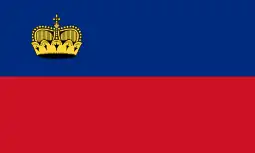 Liechtenstein[31]
Liechtenstein[31] Lithuania[36]
Lithuania[36] Luxembourg[CEPPS 7]
Luxembourg[CEPPS 7] Netherlands[CEPPS 8]
Netherlands[CEPPS 8] Norway[CEPPS 9]
Norway[CEPPS 9] Poland
Poland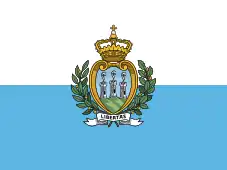 San Marino[31]
San Marino[31] Slovakia[CEPPS 10]
Slovakia[CEPPS 10] Slovenia[CEPPS 11]
Slovenia[CEPPS 11] Sweden[CEPPS 12]
Sweden[CEPPS 12].svg.png.webp) Switzerland[16]
Switzerland[16] Ukraine[37]
Ukraine[37]
Partially recognized states
Notes
CEPPS
- "Country Profile: Colombia". 2012-06-19. Archived from the original on 2016-04-02. Retrieved July 8, 2012.
- "Country Profile: Indonesia". 2010-11-26. Archived from the original on 2016-03-29. Retrieved June 30, 2012.
- "Country Profile: Sri Lanka". 2010-02-18. Archived from the original on 2016-03-26. Retrieved June 30, 2012.
- "Country Profile: Czech Republic". Archived from the original on 2017-08-16. Retrieved 2017-08-16.
- "Country Profile: Estonia". 2011-04-15. Archived from the original on 2016-03-30. Retrieved June 30, 2012.
- "Country Profile: Latvia". August 5, 2011. Archived from the original on April 2, 2016. Retrieved June 30, 2012.
- "Country Profile: Luxembourg". February 4, 2010. Archived from the original on March 27, 2016. Retrieved July 8, 2012.
- "Country Profile: Netherlands". 2010-10-14. Archived from the original on 2016-04-02. Retrieved June 30, 2012.
- "Country Profile: Norway". 2011-03-18. Archived from the original on 2016-03-24. Retrieved July 8, 2012.
- "Country Profile: Slovakia". February 1, 2012. Archived from the original on April 1, 2016. Retrieved June 30, 2012.
- "Country Profile: Slovenia". 2012-02-28. Archived from the original on 2016-03-29. Retrieved June 30, 2012.
- "Country Profile: Sweden". ElectionGuide. Consortium for Elections and Political Process Strengthening. 2010-08-08. Archived from the original on 2016-03-29. Retrieved July 8, 2012.
References
- "Hvað þurfa margir að strika út mann til að hann færist niður?". Landskjörstjórn. Archived from the original on 28 May 2022. Retrieved 28 May 2022.
- Helgason, Þorkell. "Greining á úthlutun þingsæta eftir alþingiskosningarnar 27. apríl 2013" (PDF). Landskjörstjórn. Archived (PDF) from the original on 24 January 2022. Retrieved 28 May 2022.
- "Valgloven §7-2, §11-5, §11-10, §11-12 og §6-2". Archived from the original on 2021-06-05. Retrieved 2021-06-05.
- Vorzugsstimmenvergabe bei einer Nationalratswahl ("Preferential voting in a federal election") Archived 2019-03-02 at the Wayback Machine HELP.gv.at
- "Zakon o izborima zastupnika u Hrvatski sabor (Act on Election of Representatives to the Croatian Parliament)" (in Croatian). Archived from the original on August 28, 2018. Retrieved August 27, 2018.
- "IPU PARLINE database: Czech Republic (Poslanecka Snemovna), Electoral system". Archived from the original on 2021-02-24. Retrieved 2018-08-27.
- "IPU PARLINE database: INDONESIA (Dewan Perwakilan Rakyat), Electoral system". Archived from the original on 2018-10-16. Retrieved 2018-08-27.
- Swedish Election Authority: Elections in Sweden: The way its done Archived 2009-02-25 at the Wayback Machine (page 16)
- 2022 Swedish election results, Section: Voting patterns, Personal votes in Riksdag elections (number), 2022, The Swedish electoral authority
- Ministry of Internal Affairs and Communications: Results of the 24th regular election of members of the House of Councillors Archived 2019-04-10 at the Wayback Machine: Proportional election, Japanese Communist Party results (lists preference votes by candidate and prefecture) Archived 2017-08-31 at the Wayback Machine (in Japanese)
- "Open, closed, and free lists Archived 2021-01-12 at the Wayback Machine", ACE Electoral Knowledge Network
- "Glossary of Election Terms - Federal Election 2007". ABC. Retrieved 2010-12-29.
- Senate Ballot Paper Study 2016, Australian Electoral Commission
- (in French) « Voilà comment voter électroniquement avec Smartmatic Archived 2016-09-23 at the Wayback Machine », video posted on Youtube by the Belgian Federal Interior Ministry
- "IPU PARLINE database: DEMOCRATIC REPUBLIC OF THE CONGO (Assemblée nationale), Electoral system". Archived from the original on 2021-02-24. Retrieved 2018-08-19.
- Mainwaring, Scott (October 1991). "Politicians, Parties, and Electoral Systems: Brazil in Comparative Perspective" (PDF). Comparative Politics. 24 (1): 21–43. doi:10.2307/422200. JSTOR 422200. Archived (PDF) from the original on 2016-05-08. Retrieved 2012-08-01.
- Craig Arceneaux, Democratic Latin America, Routledge, 2015 ISBN 978-1-317-34882-5 p.339 Archived 2021-02-25 at the Wayback Machine
- George Rodriguez, "Voters head to the polls in El Salvador to elect legislators, mayors Archived 2021-05-07 at the Wayback Machine", Tico Times, 28 February 2015
- (in Spanish) "Papeletas para las elecciones 2015 Archived 2021-02-27 at the Wayback Machine (reproduction of ballot papers and explanation of the new voting system)", Tribunal Supremo Electoral
- Matthew S. Shugart Archived 2021-02-24 at the Wayback Machine, "El Salvador joins the panachage ranks, president's party holds steady Archived 2021-02-28 at the Wayback Machine", Fruits and Votes, 8 March 2015
- "Honduras Archived 2021-04-24 at the Wayback Machine", Election Passport
- "IPU PARLINE database: PANAMA (Asamblea Nacional), Electoral system". Archived from the original on 2022-04-07. Retrieved 2018-08-19.
- "IFES Election Guide | Country Profile: Peru". Archived from the original on 2021-04-22. Retrieved 2018-08-19.
- "http://archive.ipu.org/parline-e/reports/2299_B.htm Archived 2018-07-15 at the Wayback Machine"
- Fijan elections office. "Electoral decree 2014" (PDF). Archived from the original (PDF) on 14 July 2014. Retrieved 3 July 2014.
- ja:非拘束名簿式
- "IPU PARLINE database: JORDAN (Majlis Al-Nuwaab), Electoral system". Archived from the original on 2018-08-19. Retrieved 2018-08-19.
- "Lebanon to hold parliamentary elections in May 2018". Archived from the original on 18 June 2018. Retrieved 23 June 2017.
- "Broshurë Informative mbi proceset zgjedhore Parlamentare dhe Lokale në Shqipëri, mbi partitë politike, legjislacionin, rekomandimet e OSBE/ODIHR (1991-2020)" [Information Booklet on Parliamentary and Local Electoral Processes in Albania, on Political Parties, Legislation, OSCE / ODIHR Recommendations (1991-2020)] (PDF) (in Albanian). Instituti i Studimeve Politike (ISP). 2020. Archived (PDF) from the original on 1 February 2021.
- "Armenia's New Electoral Code: Open vs. Closed Party Lists and Other Considerations". 12 July 2018. Archived from the original on August 24, 2022. Retrieved August 24, 2022.
- "Electoral Systems in Europe: An Overview". European Parliament in Brussels: European Centre for Parliamentary Research and Documentation. October 2000. Archived from the original on May 9, 2013. Retrieved July 6, 2012.
- "Izborni zakon BiH, članovi 9.5 i 9.8" (PDF). Archived (PDF) from the original on March 7, 2021. Retrieved September 2, 2012.
- "Report on Proportional Electoral Systems: the Allocation of Seats inside the Lists (open/closed lists)". Venice Commission. March 23, 2015. Retrieved January 24, 2023.
- "Zakon o izborima zastupnika u Hrvatski sabor (Act on Election of Representatives to the Croatian Parliament)" (in Croatian). Archived from the original on April 9, 2018. Retrieved April 8, 2018.
- Miriam A. Golden; Lucio Picci (April 2008). "Pork-Barrel Politics in Postwar Italy, 1953-94" (PDF). American Journal of Political Science. 52 (2): 268–289. doi:10.1111/j.1540-5907.2007.00312.x. Archived (PDF) from the original on 2021-03-01. Retrieved 2012-08-01.
- "IFES Election Guide | Country Profile: Lithuania". Archived from the original on 2018-08-20. Retrieved 2018-08-19.
- UkrInform: Ukrainian parliament adopts Electoral Code Archived 2021-03-08 at the Wayback Machine, Kyiv Post
External links
- British Columbia Citizens' Assembly on Electoral Reform - A debate on the merits of open and closed lists by the Citizens' Assembly on Electoral Reform in the Canadian province of British Columbia, 2004.
- "Preferential Voting: Definition and Classification" - Paper presented by Jurij Toplak at the annual meeting of the Midwest Political Science Association's 67th Annual National Conference, Chicago, IL, April 2009.